Last Chance to Catch NYC's Holiday Notalgia Train
We met the voices of the NYC subway on our nostalgia ride this weekend!


The New Yorker Hotel at 34th Street and 8th Avenue is one of those storied Manhattan icons – so much history and so many secrets, it’s hard to whittle them down. The Art Deco building, completed in 1930, is renown for its setback architectural style and famous sign but inside, you’ll discover something new on every visit. As a handy guide, we’re getting you started with ten of our favorite secrets that we learned while touring the hotel with Joe Kinney, senior project engineer at the New Yorker Hotel and creator of the archives and museum. He’s been on the hotel staff since 1996.
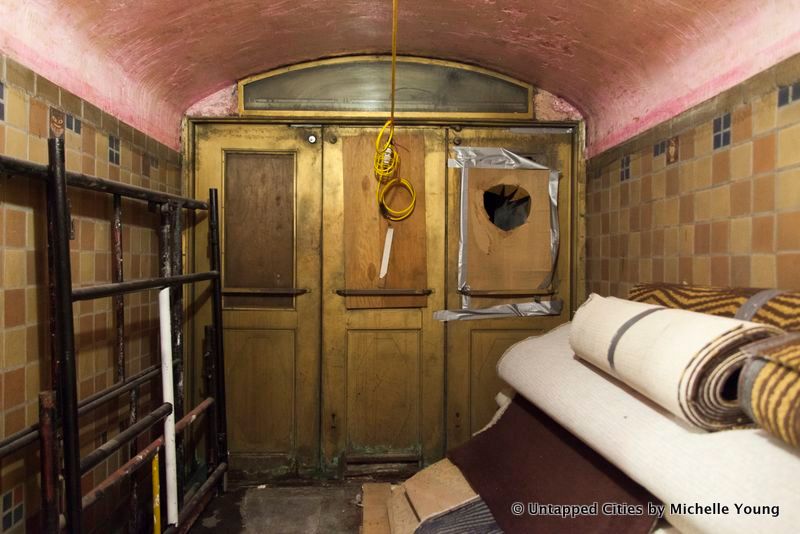
Roughly 200 feet beneath the New Yorker Hotel lies a secret: an underground tunnel that connected the establishment to Penn Station It’s mostly forgotten, used primarily as storage, but it once enabled guests to go directly from the subway and trains to an elevator and up into the hotel. A porter would greet you at the entrance and take you the rest of your way.
When the hotel opened, the Long Island Railroad was in operation but the Eighth Avenue Subway (the A/C/E lines today) was not even completed yet. It would open in 1932. An early advertisement states: “Your room is only three minutes from your train through your own private entrance to the Pennsylvania and Long Island stations. This entrance also connects with the New York subway system and when the new Eighth Avenue subway is completed in the fall of 1931, there will be subway entrances at the very doors of the hotel.” Like all things transit and New York, the opening of the Eighth Avenue subway was delayed a bit.
Kinney emphasizes that it’s important to note that the tunnels were already present before the New Yorker Hotel was built. In the late 1960s this tunnel below West 34th Street was closed and mostly disappeared from history, with many considering it an urban legend.
See more photos of the tunnel here.

The New Yorker Hotel was built atop the site of the former Manufacturer’s Trust Company Bank, which agreed to the demolition of their building as long as they were given space inside the New Yorker Hotel for their operations. They were also given free rent for fifty years, until 1980. As such, a bank space was built inside the basement and second floor of the New Yorker Hotel. Kinney himself did the schematics to make the bank vault connect to the hotel portion, and the creativity has paid off. The bank vault area will re-open as a bar sometime this year, dubbed The Bar Below. For the renovation into the bar, designers took the doors off the safety deposit box and glued them onto the wall to gain a few feet. The terrazzo floor is partially original to the bank.
Fun fact: Manufacturer’s Trust Bank was acquired several times, merging into new companies that would eventually become the ubiquitous Chase Bank. The bank space laid fallow for decades after.
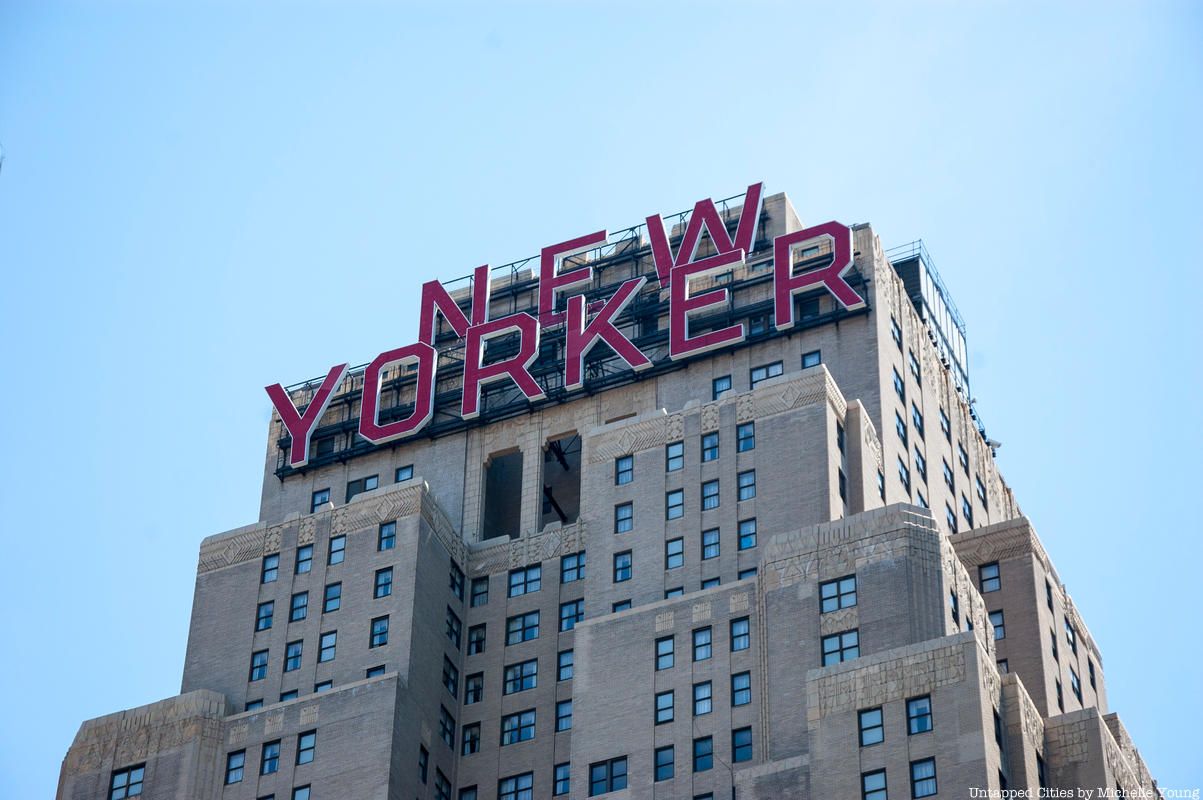
Wyndham operates the New Yorker Hotel but the building is owned by the Unification Church, the religious group founded by Reverend Sun Myung Moon. “The Moonies,” as they are nicknamed, purchased the building in 1976 for $5 million, after the hotel itself closed in 1972 during the peak of financial troubles in New York City. The Moonies used the building as a headquarters and for housing.
On July 1st, 1982 a mass-wedding of over 4,000 people took place inside the Grand Ballroom of the New Yorker Hotel. The contracts between strangers from within the church, assigned together by Revered Moon, were drawn up in the ballroom, and the ceremony took place in Madison Square Garden, officiated by Moon.
Where the Ticktock Diner is, says Kinney, has always been a restaurant establishment since its inception.

The locomotive steam engine in the basement of the New Yorker Hotel
“The New Yorker Hotel was the most advanced hotel in the world technologically when it was built,” says Kinney. It’s 1 million square feet above ground and 200,000 square feet below ground. The Institute of Electrical and Electrical Engineers (IEEE) named the New Yorker Hotel an IEEE Milestone in Electrical Engineering and Computing for having the “largest (DC) generating plant in the United States” when it was built. It was also one of the first cogeneration power plants in the world. There are only a little over one hundred IEEE milestone sites in the world, and the New Yorker Hotel joins the ranks of places like Niagara Falls and Bell Laboratories.
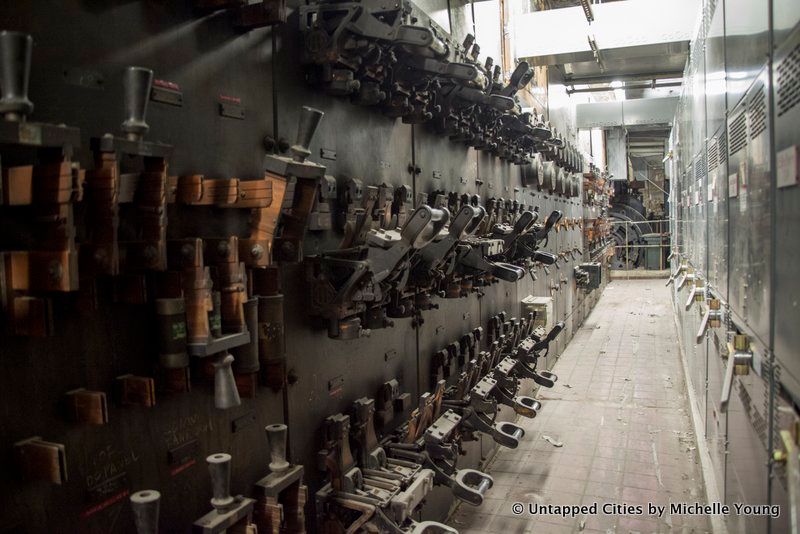
The switchboard, which included labels for ice rink and other locations
The power plant was installed in 1929 and had enough capacity to provide electrical power for a city of 35,000 people. As such, the hotel remained completely off the power grid for thirty years. High pressure boilers made 180 pound steam, sending it over to a massive eightl cylinder diesel locomotive steam engine that powered the direct current electric generators. Exhaust steam was used for heating and other activities within the building, providing the cogeneration part of the plant. Down in the basement, you can still see the motors, over 200 of them, and a sixty-foot long switchboard, which Kinney refers to as the “Frankenstein board.”
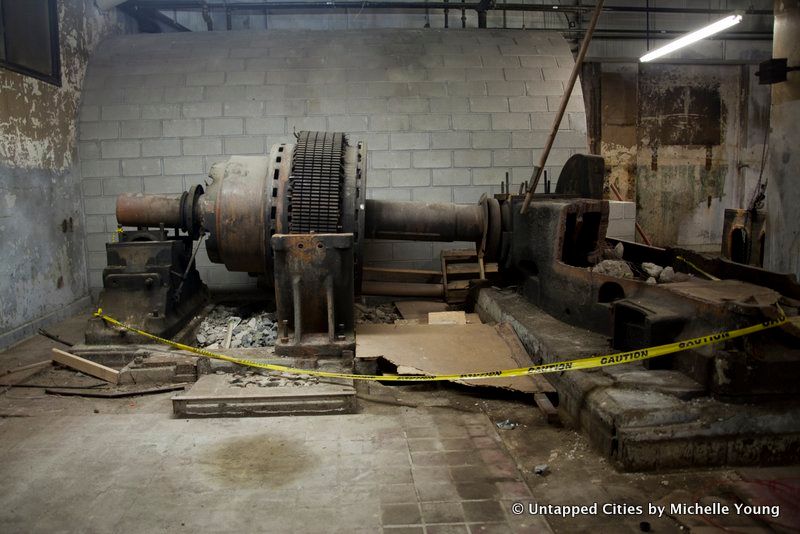
A former direct current generator
When Kinney arrived to the hotel, he proposed moving the building off of Con-Ed steam and have the hotel make its own again at one-third the cost. This boiler system he devised, replacing the high pressure boilers with low pressures ones, saves the hotel 3 to 4 million dollars a year and kept the business solvent during some difficult years.
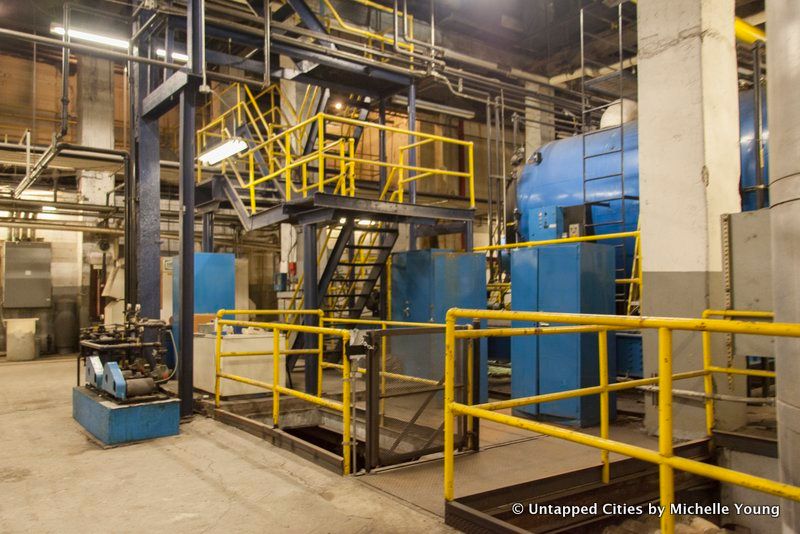
The current boiler system

Vintage advertisements via Joe Kinney at the New Yorker Hotel Archives
When it opened on January 2nd, 1930, the New Yorker Hotel equipped every hotel room with a radio. In 1948, the hotel had the most televisions within a single building in the world. There were “Protecto-Ray UV lights in the bathrooms” for sanitization starting in 1941 – with the added benefit of having all treated bathrooms sealed with cellophane!

Vintage advertisements via Joe Kinney at the New Yorker Hotel Archives
Even the layout of the bank was acclaimed for its forward thinking thoughtfulness towards women customers. The February 1930 edition of Metalcraft magazine devoted a long feature to the New Yorker Hotel’s and included the following:
The banking layout well illustrates the growing importance of women in the financial world…A special room has been provided for the use of women having desks and other conveniences to enable them to complete business papers with dispatch as well as privacy.

Original architectural plans for the New Yorker Hotel
On his own initiative, Kinney has collected over 4,000 historical images of the New Yorker Hotel for the archive and museum, among other memorabilia like menus, original mail chutes, signage and much more. Kinney was able to track down the original floor plan drawings which were no longer in the collection of the hotel when the building was sold to the Unification Church in 1976. They were given to an architect and someone who had them gave Kinney a call and offered them to the archive. They are massive at 4 feet by 5 feet.
In a hallway area in the hotel, Kinney has framed and written out important parts of the history of the hotel, to the backdrop of jazz age music. This includes not only the technological advancements, but also information about famous guests ranging from Muhammad Ali to the Reverent Moon.
He has a high quality scanner and keeps a meticulous online archive, constantly looking for new memorabilia that comes available. There’s an order to the madness of the physical collections of his two room archive and office – a Tesla section, a portion on the Big Bands who have performed and recorded there, a section of the original menus printed by the hotel. He’s currently working on a book about the New Yorker Hotel, even doing the layout of the book himself.
From 1933 until his death a decade later, Nikola Tesla lived in rooms 3327 and 3328, on the 33rd floor of The New Yorker Hotel. The room itself has been renovated (you can see photos of it in an earlier state on the Tesla society website). Kinney believes Tesla chose to live in the New Yorker Hotel precisely for its technological advancements, despite its use of direct current (DC).
As The New Yorker recounts, Tesla died penniless, having failed to capitalize on his revolutionary discoveries. But today, he has his legions of followers who make the trek to rooms 3327 and 3328. Dr. Ljubo Vujovic, Secretary General of the Tesla Memorial Society of New York writes that Tesla relocated to The New Yorker from the Waldorf-Astoria.
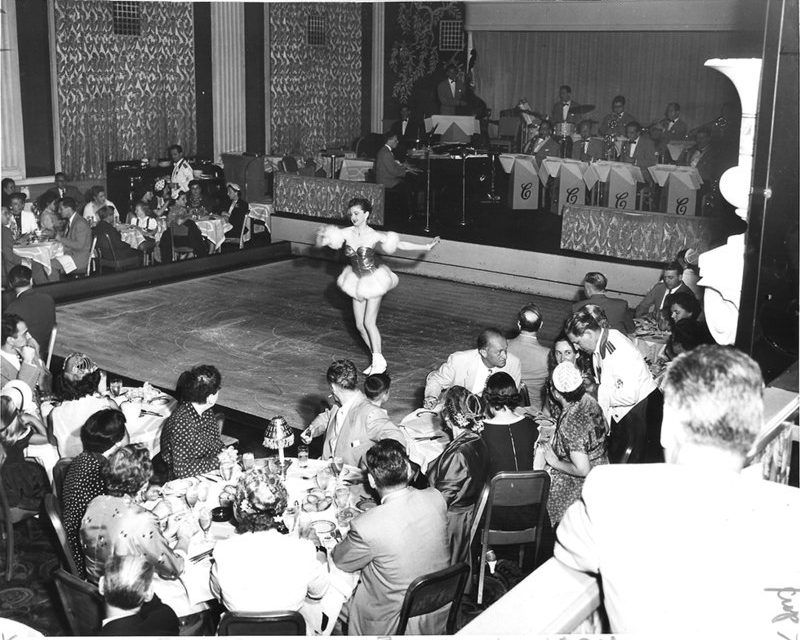
Retractable ice rink in the Terrace Room of the New Yorker Hotel. Photo via Joe Kinney at the New Yorker Hotel Archives
Under the bandstand of the Terrace Room of the New Yorker Hotel was once a retractable indoor ice skating rink that could move in and out as needed. The ice rink was constructed out of connecting swaths twenty feet long and four feet wide, refrigerated to keep cool. The Ice Follies of the New Yorker Hotel performed to the live music of Benny Goodman daily while guests ate and imbibed at lunch, dinner and supper.
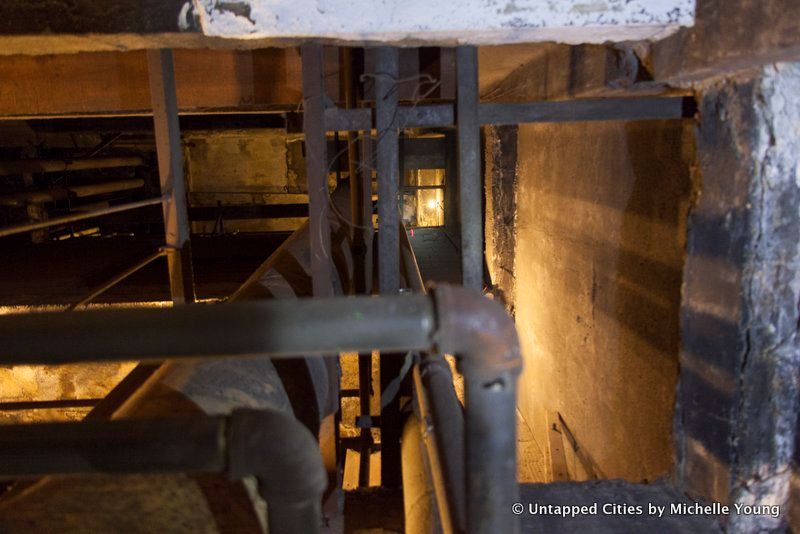
You can see the bottom side of the 34th Street sidewalk from a hidden air shaft next to the power plant located behind a small metal door. It brings air into the building and goes about way, way up.
The doorway, before Kinney opened it up for us:
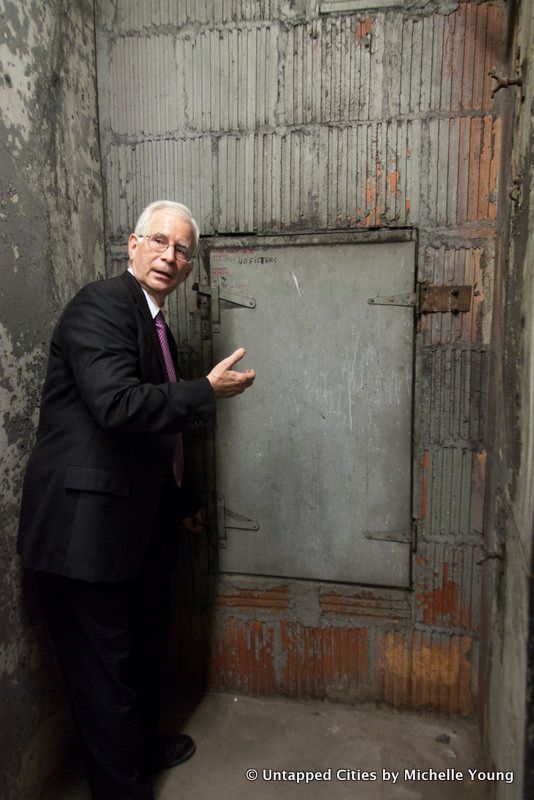
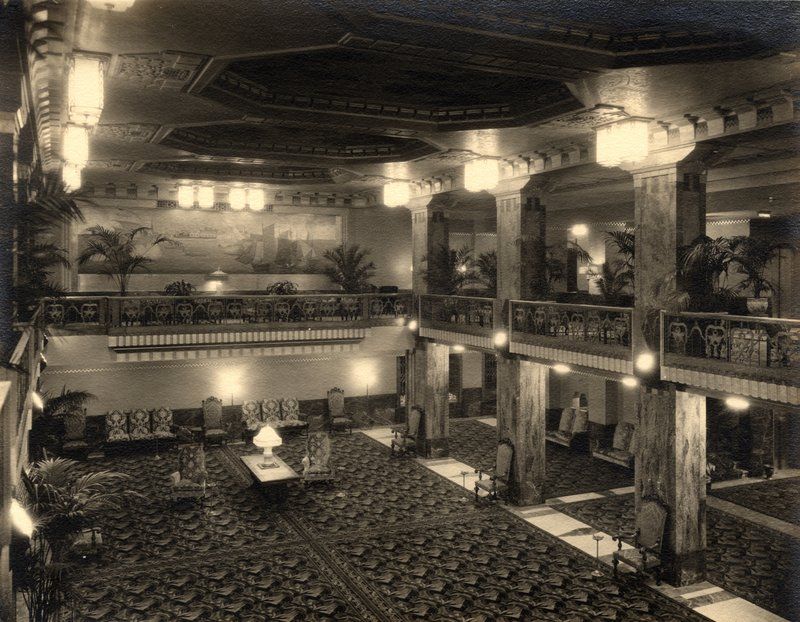
New Yorker Hotel Lobby in 1930s. Photo via Joe Kinney at the New Yorker Hotel Archives
Hungarian immigrant and artist Luis Jambor painted 26 murals in the New Yorker Hotel spread throughout in the lobby and Grand Ballroom. One of the lobby murals was historical and depicted the settlement of New York by the Dutch. On the other end of the lobby, another showed the skyline of Manhattan. There were also ceiling panels, with a gold background.
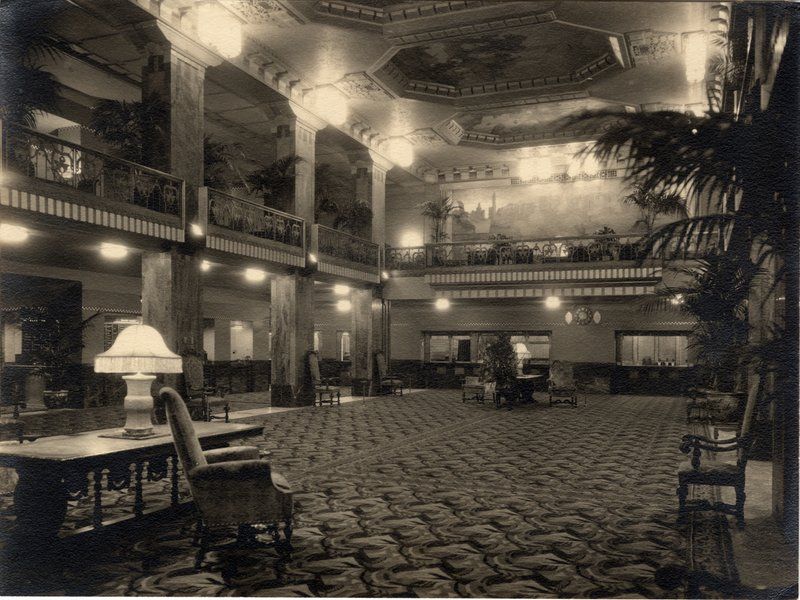
New Yorker Hotel Lobby in 1930s. Photo via Joe Kinney at the New Yorker Hotel Archives
Most of the murals appear to have been covered or removed in the numerous renovations. Kinney himself has only seen two, located in the banking hall but covered. The rest, he says, could either be buried treasure beneath later layers or completely lost forever.
Next, see more photos of the hidden tunnel to Penn Station in the New Yorker Hotel and discover the Secrets of the Waldorf-Astoria Hotel.
Subscribe to our newsletter